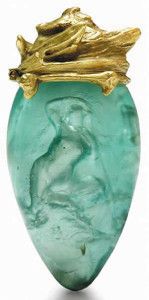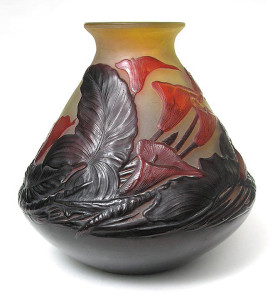Prices for 19th and early 20th century examples of Art Glass sell for thousands of dollars when they come to auction. Just because you can’t afford them doesn’t mean you shouldn’t know the many terms and techniques describing them. As “Antiques Road Show” often proves, people who inherit them have no idea of what they have or values. Names of the most famous makers such as Gall’e, Lalique and Daum are unknown as well as their descriptions. Many of the techniques developed by ancient Egyptians and Romans were revived and adapted by them.
When the Romans conquered Egypt in 27 B.C. they introduced glass blowing. By the 2nd century A.D. migrant craftsmen had carried their techniques to the Roman Colonies.
Historically, glass factories had opened by the end of the 1st century A.D. in Germany, Belgium and England. While most of the objects were utilitarian, decorative objects were slowly introduced.
Do you think the term “cameo glass” describes glass with a cameo profile of a person, you are both right and wrong. In one instance cameo glass is layered or cased. The outer layer(s) are then partially removed to create designs in relief, against contrasting color backgrounds. Using this same technique a “cameo” profile can be made. French glass makers excelled in this technique.
 Another ancient technique, “pate de verre”, (powdered) glass made into a paste, colored and molded was rediscovered and used in a new way.
Another ancient technique, “pate de verre”, (powdered) glass made into a paste, colored and molded was rediscovered and used in a new way. The molded glass, we now know as cir’e perdue or the “lost wax process.” It began with an object modeled in wax, then covered with clay. After the wax was melted and was poured away, the space would be filled with molten glass. During the Art Nouveau decades the process was revived.
Painted glass involves yet another technique that is divided into many others. Lustre-painting, first used in ancient Egypt, consisted of films of color painted onto the body of the piece. When fired it turned lustrous. Enameling dates back to the 15th century B.C. Colors are fused to the piece by refiring. The enamel is made of a finely powdered metallic coloring agent, mixed with oil, painted on glass then fired.
If you can’t visit a museum or auction, the next best thing is the auction catalogs on the internet. Good photos and descriptions.
PHOTOS: (1) French cameo glass vase. Galle’ (calla lilly.) Philip Chasen Antiques. (2) Cold painted Bohemian glass vase by Moser. (3) Cir’e perdue perfume bottle by Ren’e Lalique. (3) faytinakay/lalique-treasures-glass/
















Follow Us